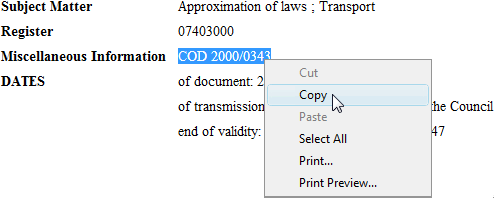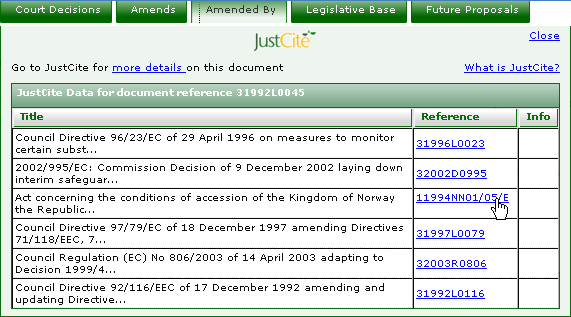CELEX – Searching Tips
Here are some tips to help you find what you are looking for in the CELEX database on Justis.
- Tracing the development of a document
- Searching for a Document Number
- Constructing a Document Number
- Searching for a Treaty
- Using colloquial terms
- Publication reference formats
- Searching for a Directive
- Searching for Directives within a range of dates
- Searching for the Directive resulting from a Proposal
- Locating consolidated documents
- Locating an Explanatory Memorandum
1. Tracing the development of a document
Directives, Regulations, Treaties and other EU documents go through several stages before they reach their final form. Justis gives you access to lists of documents in the CELEX database that amend, or are amended by, or otherwise interact with, the one you are viewing on the Document screen. Click one of the green JustCite tabs (Court Decisions, Amends, Amended By, Legislative Base, Future Proposals) to see lists of documents, with links to view them.
The information on the green JustCite tabs is based on several CELEX fields, including the Court Decision field, the Documents Amended field, the List of Amendments field, the Legislative Base field, and the Future Proposals field.
2. Searching for a Document Number
Each document in the CELEX database has a complex, unique number assigned to it.
You can search for a complete number using either the Reference field on the Search In EU screen.
If you do not know the complete number, you can use wild cards in place of the numeric portions of document numbers, but only in the Full Text box. For example, you could search for: 3????R2027.
4. Searching for a Treaty
The Treaties are located in the Treaties database, and each of the major treaties has its own letter code that is used in the Sector and Year field and in the Reference field. The codes are:
| A | Treaty Establishing the European Atomic Energy Community (1957) |
| B | Accession Treaty (Denmark, Irish Republic, Netherlands, United Kingdom) (1972) |
| C | Treaty of Nice, amending the Treaty on European Union, the Treaties establishing the European Communities and certain related Acts (2001) |
| D | Treaty of Amsterdam, amending the Treaty on European Union, the Treaties establishing the European Communities and certain related Acts (1997) |
| E | European Economic Community Treaty (1957); European Communities Treaty consolidated version (1992) |
| F | Treaty establishing a single Council and a single Commission (1965). Treaty amending certain budgetary provisions (1970) |
| G | Amending Treaty (Greenland) (1985) |
| H | Accession Treaty (Greece) (1979) |
| I | Accession Treaty (Portugal, Spain) (1985) |
| K | European Coal and Steel Community Treaty (1951) |
| M | Treaty on European Union, i.e. Maastricht Treaty (1992) |
| N | Accession Treaty (Austria, Finland, Sweden) (1994) |
| R | Treaty amending certain financial provisions. Treaty amending certain provisions of the statute of the European Investment Bank (1975). Act amending the protocol on the statute of the European Investment Bank (1993) |
| U | Single European Act (1986) |
To find all of the documents that make up a particular treaty, search for something like:
1????D*
in the Reference field, where “1” indicates the Treaties database and “D” is the code for the treaty.
You can also use the colloquial terms for some Treaties, using the Reference field.
5. Using colloquial terms
Some of the documents in the CELEX database have become so well-known that they have acquired one or more unofficial names. You can search for some of these names using the Reference field. Colloquial terms are available for:
- European Union Conventions
- European Union Decisions
- European Union Directives
- European Union Regulations
- European Union Treaties
7. Searching for a Directive
i) Some Directives become so well-known that they acquire one or more unofficial names. You can search for the recognised names for Directives using the Reference field.
ii) You can find all Directives by searching for “Directive” in the Document Type field. You will probably want to narrow your search by including one or more words from the Title field or the Subject Matter field in your query.
8. Searching for Directives within a range of dates
You can find all Directives by searching for “directive” in the Document Type field.
You can find all documents within a range of dates by searching the Date of Publication field.
Putting the two together, you can find all Directives within a range of dates with a Full Text query like this:
form[directive] and pub[from 1 july 2000 to 31 december 2000]
9. Searching for the Directive resulting from a Proposal
If you want to find a Directive but you only have the CELEX document number for a Proposal (for example, 52001PC0532), you first need to find the document in the CELEX Proposals database. To do this, type or paste the document number into the Reference text box on the Search In EU screen and click the Search button.
![]()
On the Document screen, scroll down to the Miscellaneous Information field (or use the Outline to jump there), and select and copy the contents of the field.

Go back to the Search In EU screen, and search for this text in the Miscellaneous Information field in the CELEX Legislation database. (You will probably need to use Add / Remove Fields to make the Miscellaneous Information field appear.)
![]()
This should find and display the appropriate Directive.
You can find related Proposals by searching the CELEX Proposals database instead of the Legislation database.
10. Locating consolidated documents
The CELEX database does not contain many consolidated documents, but it does contain references to sets of related documents which have been consolidated into one text. These references are contained in the Publication Reference field and include the tag “consleg”.
Those consolidated documents that are present in CELEX can be found by searching the Title field and including the word “consolidated” in the search:
title["treaty on european union" and consolidated]
Consolidated documents are produced by the Consleg system developed by EUR-OP, and are the result of work by EUR-OP on the transparency and accessibility of legislation.
CELEX consolidated documents are meant purely as a reference aid, and the institutions of the Community do NOT assume any liability for their content. Nevertheless, they provide useful guidance to the current version of a group of Directives and Regulations which have, over the years, been heavily amended.
Creating a consolidated text involves physically incorporating all amendments, corrections, deletions and additions provided in the amending legislation to the original Act. The resulting document is then filed in electronic form in the European document repository archive file EUDOR.
In CELEX Sector 3, the flag “consleg” is present in the Publication Reference field in all those documents affected by the consolidation process. These can be listed by the search:
pubref[consleg]
which, in December 2001, gave 2897 references.
The Publication Reference field gives a reference number to the originating Directive or Regulation. This is in the form of the CELEX document number, but without the initial digit for the sector number, and sometimes with a 2-digit year.
For example:
| Document Number | 31994L0060 |
| Publication Reference | Official Journal L 365 , 31/12/1994 P. 0001 - 0009 Finnish special edition....: Chapter 13 Volume 29 P. 0273 Swedish special edition...: Chapter 13 Volume 29 P. 0273 CONSLEG - 76L0769 - 31/12/1994 - 71 P. |
A search for:
docnum[31976L0769]
will supply the originating Directive 76/769 (which will also have the reference “consleg 76L0769” in its Publication Reference field).
Thus the search:
pubref[consleg and 76L0769]
will yield a list of 19 documents, the original Directive 76/769 plus 18 documents which amend it.
The text of the consolidation is NOT in CELEX but can be obtained from EUR-Lex. The consolidated document facility is useful, but should be used with some care.
Note: For sets of related documents that have not yet been consolidated, continue to use the Documents Amended field and the List of Amendments field to find all amending documents.
11. Locating an Explanatory Memorandum
For some EU legislation, an Explanatory Memorandum is published in the C Series of the Official Journal of the European Union, and included in the CELEX Proposals database.
One way to locate the Memorandum is to search for a phrase from its title together with the phrase “explanatory memorandum”, for example:
![]()
This will either go directly to the document, or else to a list of matching documents.
A second way to locate a Memorandum is to use the Legislative History (prepwork) field:
- Display the legislation document for which you would like to see an Explanatory Memorandum.
- Click the blue Outine tab.
- Click the “Legislative History” link.
- Close the Outline by clicking the blue tab again.
- With your mouse, select the reference of a COM DOC.
![]()
- In the Document Actions panel, click the “J-Link” button
- A new document will appear, which may be the Memorandum.
- If the new document is not the one you want, return to the legislation document and try any other COM DOC references in the Legislative History field.
cxe-tips.html; last updated 27th September 2007
Copyright © 2006–2007 Justis Publishing Limited
